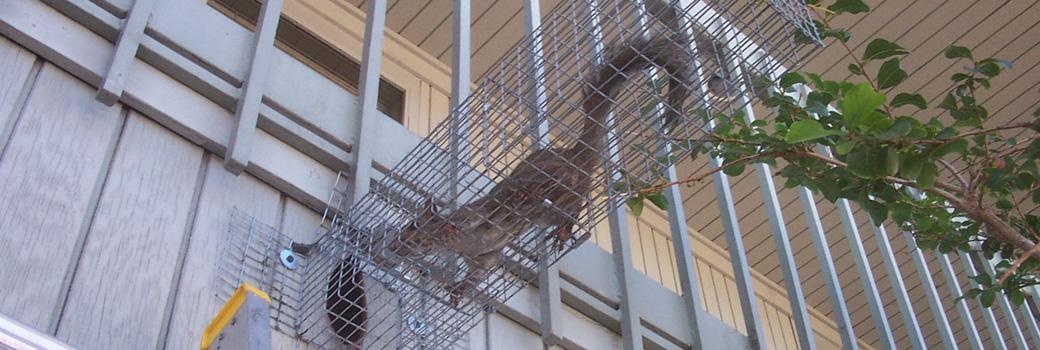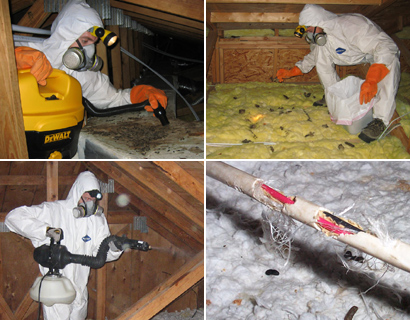- How We Solve Florida Wildlife Problems
How We Solve Miami Wildlife Problems
INSPECTION: Once on site, we will perform a full inspection of your home and property. This allows us to use the correct strategy and traps. If the animals are in an attic, a full building inspection is crucial, including the following:
- All ground-level areas, such as piper or A/C line entry & exit areas, A/C chase bottoms, ground-level vents, etc.
- All mid-level areas, such as dryer vents, siding gaps, first floor eaves or dormers, etc.
- We inspect the entire roof, including all plumbing stacks, ridge caps, vents, and other potential gaps or holes.
- We also inspect inside your attic, to identify animals and damage they have caused.
- If the animals are outside, we notice many subtle clues that will assist us in a successful strategy.
TRAPPING, EXCLUSION, REMOVAL: Once we understand what animal species we are dealing with, and the problem, we use the most effective means of removing the animals. We use dozens of different types of traps.
- Trapping - If trapping the animal(s) in live cage traps, trap type, set, and location are crucial to success.
- Exclusion - Oftentimes, we are able to simply set one-way doors or other exclusion devices that allow the animals inside a building to safely exit, but never get back inside.
- Removal By Hand - Sometimes we actually remove animals by hand, or with special tools like snare poles.
- The Law - In all cases, we obey state and local laws regarding wildlife, but aim to take the most humane approach.
ENTRY HOLE REPAIRS: Repairs are a crucial step in the wildlife removal process. In many cases, such as bat or rodent control, the job cannot be performed without detailed repairs, and in all cases, sealing the entry holes shut ensures that no future wildlife will ever enter your home.
- 100% of the entry holes must be found, and sealed shut, or the job is not complete.
- Our repairs are professional contractor grade, look good, and when applicable we use steel, which rodents such as rats or squirrels are unable to chew through.
- We give a written guarantee on our repairs against any future animal entry.
ATTIC DECONTAMINATION SERVICES: It may be desirable to clean your attic after we've removed the animals. They can leave behind large amounts of droppings, urine, hair, oils, food, nesting material, and so on. These remnants can attract insects like cockroaches, and the scent left behind can encourage new animals to chew their way into your house. You might experience odor problems from the waste. It's possible that mold will grow on waste areas.
- We remove or vacuum all droppings, or remove all the soiled insulation.
- We fog the attic with a special enzyme-based cleaner that destroys any organic matter and deodorizes the space.
- We repair damage, such as ductwork, electrical wires, pipes, insulation, and more.
Florida is known for its reptiles! If you find yourself in a situation where you have one of Miami's reptiles, such as snakes, on your property give us a call! Some of these snakes can cause serious injuries or even death if they aren't handled by a trained professional. Of Florida's 46 native species of snakes, about 34 are found in the South Florida region, including four of the six venomous species. We service the greater Miami area, including: Hialeah, Weston Broward, Pembroke Pines, Hollywood, Miramar, Coral Springs, Pompano Beach, West Palm Beach, Davie, Plantation, Boca Raton, Sunrise, Deerfield Beach, Atlantis, Bal Harbour, Bay Harbor Islands, Belle Glade Camp, Hypoluxo, Indian Creek, Islandia, Lake Harbor, Lake Park, Medley, Mission Bay, Naranja, North Bay Village, Ocean Ridge, Richmond Heights, Roosevelt Gardens, Surfside, West Perrine, Westview, Boynton Beach, Lauderhill, Fort Lauderdale, and Homestead. We also service the following counties: Sarasota County, Palm Beach County, Brevard County, Lake County, Alachua County, Volusia County, Broward County, Pinellas County, Seminole County, Polk County, Citrus County, Putnam County, Indian River County, Lee County, St. Lucie County, Hernando County, Marion County, Gadsden County, Duval County, Orange County, Sumter County, Osceola County, Flagler County, Walton County, Martin County, Bradford County, Manatee County, Bay County, Hillsborough County, Wakulla County, Collier County, Monroe County, Charlotte County, Hendry County, Leon County, Levy County, Okaloosa County, Pasco County, Escambia County, Highlands County, Baker County, Holmes County, Lafayette County, Hardee County, Clay County, St. Johns County, Nassau County, Okeechobee County, Gilchrist County, and Santa Rosa County.
Other Miami animal pest control topics:
How to Remove a Squirrel From a Building
What Diseases do Rats Carry
Is it Legal to Trap a Raccoon
Quality Beneficials of Bats
To learn more about our services, visit the Miami wildlife control home page.
This month's wildlife how-to article: How well can squirrels climb and jump?
How well can squirrels climb and jump?
Squirrels one of the cute animals that can actually take the house down. A lot of time, squirrels are rodent and their teeth constantly grow. They have to gnaw to make themselves comfortable. As they spend a lot of time energy eating. Their sharp teeth enable them to crack hard surfaces like nuts and if they don’t have access to the walnuts, they look for woods or chimneys everything that is not metal. Squirrels have long been known to cause trouble like gnawing on wires and cost damages financially and physically to properties. Some commercial buildings also experience power outages when the squirrels appear. And because their nature are wild, squirrels make a pretty high jump. A squirrel can jump up to 4 to 5 feet. Vertically they can reach a rooftop or leap between objects. This is why, catching squirrels with bare hand is difficult to do. These animals can scale trees and houses.

Using their back foot toes and supported by the tails, they can cling to objects. They can hang upside down using front paws. This is why many squirrel preventions involve something sticky so they won’t be able to climb up your home. They also have that habit of hoarding foods for later time. They have a high sense of smell even from distances. Many home owners complain about eating their woods and bird feeders and this could be a never ending cycle. For homes with bird feeders, squirrels can actually climb on the pole. Bird feeders can attract squirrels and they would want to climb with their sharp nails. This is why it’s important to make the feeder squirrel-proof. Many claimed this worked great to avoid the animals from climbing up.
Squirrel can jump and run fast
Squirrel has high twitch muscle. This is why they are agile. Their paws can grip on many types of surfaces as long as they aren’t slippery. Moreover, they go fast and head to anywhere they like as they swivel. It is hard to catch them or make them go away from bird feeders because they can climb up within seconds and damage everything. Squirrels especially the eastern gray type, can jum up to 9 feet horizontally. Their strong feet is in the nature despite how old a squirrel is. They can run and jump up or down or even glide. When it comes to running, a squirrel can run as fast as 12 miles per hour. This speed means fast! This is why, height is not a matter for a squirrel because they can move around as fast as they can.





